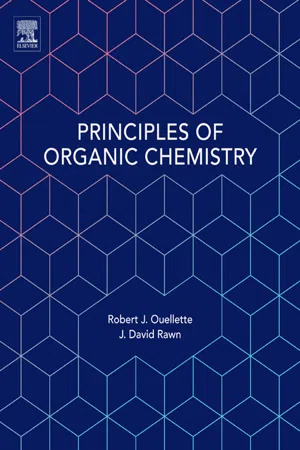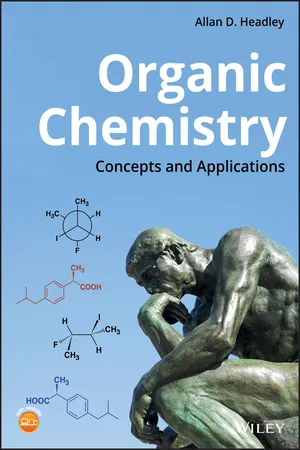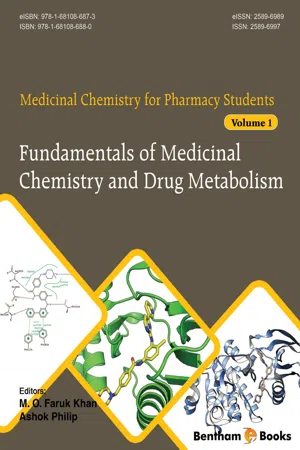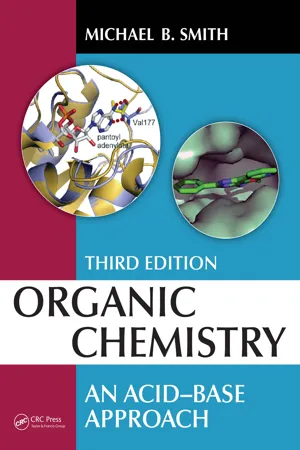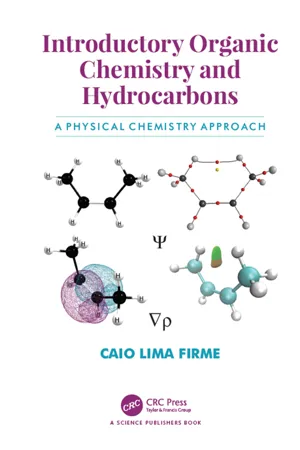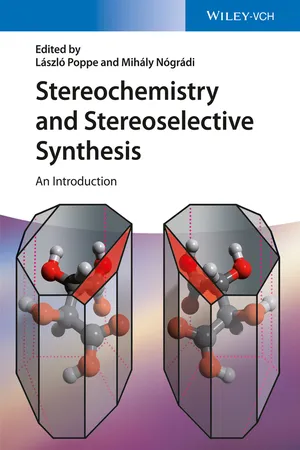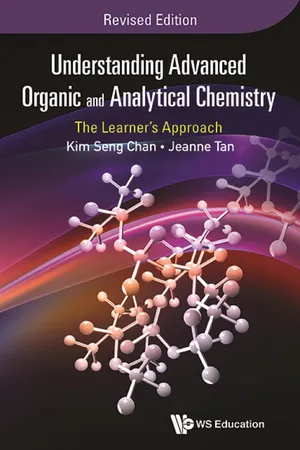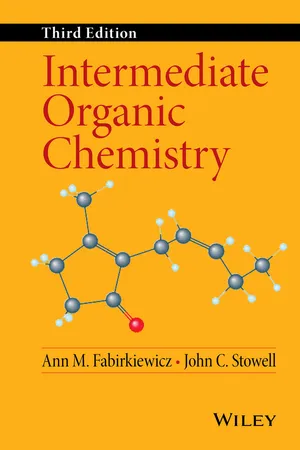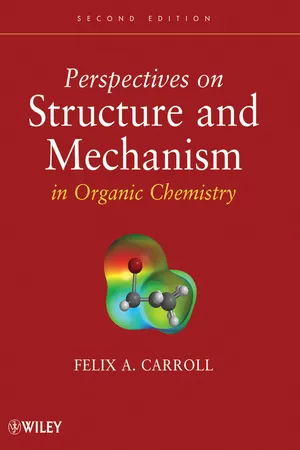Chemistry
Stereoisomerism
Stereoisomerism refers to the phenomenon where two or more compounds have the same molecular formula and connectivity of atoms, but differ in the spatial arrangement of their atoms. This results in different physical and chemical properties. Stereoisomers can be further classified as geometric (cis-trans) isomers or optical (enantiomeric) isomers, depending on the nature of their spatial arrangement.
Written by Perlego with AI-assistance
Related key terms
Related key terms
1 of 4
Related key terms
1 of 3
11 Key excerpts on "Stereoisomerism"
- eBook - ePub
- Robert J. Ouellette, J. David Rawn(Authors)
- 2015(Publication Date)
- Elsevier(Publisher)
6Stereochemistry
6.1 Configuration of Molecules
In Chapters 3 and 4 we considered the structures of geometric isomers, which are one of a general class of stereoisomers. Stereoisomers have the same connectivity—the same sequence of bonded atoms—but different arrangements of the atoms in space. The different three-dimensional arrangements of atoms in space determine their configurations. Geometric isomers have different configurations. The configuration of a molecule plays a major role in its biological properties. Stereoisomers often have entirely different biological properties. Geometric isomers invariably elicit different responses in organisms. For example, bombykol, the sex attractant of the male silk-worm moth, has a (Z)/(E) arrangement about the double bonds at C-10 and C-12. It is 109 to 1013 times more potent than the other three possible geometric isomers. Disparlure, the sex attractant of the female gypsy moth, is biologically active only if the alkyl groups bonded to the three-membered ring are in a cis configuration.Geometric isomerism is only one type of Stereoisomerism. Another type of Stereoisomerism is the result of the minor image relationships between molecules, the subject of this chapter. These molecules differ in configuration about an sp3 -hybridized, “tetrahedral carbon” atom bearing four different groups of atoms, which is called a stereogenic center. This phenomenon is not as easily visualized as geometric isomers, but its consequences are even more vital to life processes.6.2 Mirror Images and Chirality
The fact that we live in a three-dimensional world has important personal consequences. In the simple act of looking into a mirror, you see someone who does not actually exist—namely, your mirror image. Every object has a mirror image, but this reflected image need not be identical to the actual object. Let’s consider a few common three-dimensional objects. A simple wooden chair looks exactly like its mirror image (Figure 6.1 ). When an object and its mirror image exactly match, we say that they are superimposable. - eBook - ePub
Organic Chemistry
Concepts and Applications
- Allan D. Headley(Author)
- 2019(Publication Date)
- Wiley(Publisher)
5 Stereochemistry 5.1 Introduction In a three‐dimensional world, our analysis of atoms and molecules must be from that perspective. In this chapter, a detailed examination of the three‐dimensional arrangement of atoms in a molecule will be carried out. The study of differences in isomers brought about by differences in location of atoms or groups in molecules in three‐dimensional space is called stereochemistry. Geometric and conformational stereoisomers have already been examined in the previous chapter. Geometric isomers differ from each other based on the arrangement of the atoms or groups across a rigid plane, such as a double bond or rigid cyclic ring in the molecule. For example, trans ‐1,2‐dichloroethene is different from cis ‐1,2‐dichloroethene since the chlorine atoms are on different sides of the rigid double bond. On the other hand, conformational isomers differ from each in that groups or atoms in the molecule are in different locations due to rotation about a single bond, typically a carbon–carbon single bond. Thus, the anti‐conformer of 1,2‐dichloroethane is different from the gauche conformer. These conformers are different only in the spatial arrangement of the groups around the carbon–carbon bond; and as a result, their relative energies are different. For some stereoisomers, it is extremely difficult to visualize differences that result in three‐dimensional space for molecules brought about by different spatial arrangements of the atoms or groups, unless a model set is used. Stereochemistry is the study of molecules that have the same atom–atom connectivity, but the spatial arrangement among the groups or atoms is different, resulting in different molecules, known as stereoisomers. Just as a pair of shoes looks similar, but the spatial arrangements in three‐dimensional space are different. Try putting on the left foot of the shoe on your right foot, it just will not fit since it is different from the right foot of a pair of shoes - M. O. Faruk Khan, v Philip(Authors)
- 2018(Publication Date)
- Bentham Science Publishers(Publisher)
L -isomer, which may account for its differential absorption, protein binding and metabolism. Thus, the chirality or stereochemistry of drugs is an important factor to be considered for therapeutic agents. The following sections consider different stereochemical features of drugs. Definitions and illustrations are included to aid in understanding the different conformational and configurational aspects of drugs.Stereochemical Definitions and Illustrations
Isomers are molecules with identical molecular formulas but different structural formulas or different stereochemical formulas and hence different physical and/or chemical properties. Molecules having identical molecular formulas but different structural formulas are termed structural isomers. For example, ethanol (CH3 CH2 OH) and methyl ether (CH3 OCH3 ) are structural isomers as both have the same molecular formula (C2 H6 O), but different connectivity of atoms. Structural isomers would be expected to have very different physical/chemical characteristics (i.e. color, melting point, solubility, etc.).Stereoisomers come about from chirality or from restricted rotation such as in a ring or olefinic (double) bond. There are two obsolete terms that have been used in the past with respect to stereoisomers. The first, optical isomers, is used to describe stereoisomers with different optical properties. These optical properties arise from chirality and will be discussed under that topic. The second, geometric isomers, is used to describe cis-trans isomerism.Chirality is a geometric property whereby a molecule (or any rigid object for that matter) is not superimposable on its mirror image. Chirality arises either from chiral centers or from restricted rotation, referred to as axial chirality. Stereoisomers have identical molecular and structural formulas but they have different spatial arrangements of the same groups. Physical or chemical characteristics of steroisomers are usually different (except see enantiomers).- eBook - ePub
Chemistry for Pharmacy Students
General, Organic and Natural Product Chemistry
- Lutfun Nahar, Professor Satyajit D. Sarker(Authors)
- 2019(Publication Date)
- Wiley(Publisher)
Chapter 3 StereochemistryLearning objectives
After completing this chapter, students should be able to- define stereochemistry;
- outline different types of isomerisms;
- distinguish between conformational isomers and configurational isomers;
- discuss conformational isomerism in alkanes;
- explain the terms torsional energy, torsional strain, angle strain, enantiomers, chirality, specific rotation, optical activity, diastereomers, meso compounds and racemic mixture;
- designate configuration of enantiomers using D and L system, and (R) and (S) system;
- explain geometrical isomerism in alkenes and cyclic compounds;
- outline the synthesis of chiral molecules;
- explain resolution of racemic mixtures;
- discuss the significance of Stereoisomerism in determining drug action and toxicity.
3.1 STEREOCHEMISTRY: DEFINITION
Stereochemistry is the chemistry of molecules in three dimensions. This is an important branch of chemistry that deals with various chiral molecules and stereoisomers. In organic chemistry, subtle difference in spatial arrangements in organic molecules renders prominent effects on their chemical reactivity and pharmacological actions. Thus, a clear understanding of stereochemistry is crucial for the study of complex molecules that are biologically important, for example, proteins, carbohydrates and nucleic acids, and also drug molecules, especially in relation to their behaviour and pharmacological actions including toxicities.Louis Pasteur, a well‐known French biologist, chemist, and microbiologist, is the first stereochemist, who observed that salts of tartaric acid collected from wine production vessels could rotate plane polarized light, but that salts from other sources did not; this observation was made in 1849. Before we go into further details, let us have a look at different types of isomerism that may exist in organic molecules.3.2 ISOMERISM
Compounds with the same molecular formula but different structures are called isomers. For example, 1‐butene and 2‐butene have the same molecular formula, C4 H8 , but structurally they are different because of the different position of the double bond. There are two types of isomers: constitutional isomers and stereoisomers - eBook - ePub
Organic Chemistry
An Acid-Base Approach
- Michael B. Smith(Author)
- 2022(Publication Date)
- CRC Press(Publisher)
Chirality, Enantiomers, and DiastereomersDOI: 10.1201/9781003174929-9The video clips for this chapter are available at: https://routledgetextbooks.com/textbooks/9780367768706/chapter-9.phpThis chapter will focus on a class of isomers that differ only in the spatial arrangement of attached atoms and groups about an atom. When two different molecules have the same atoms, groups, and the same empirical formula, they are isomers. When they have the same points of attachment (the same connectivity), but differ in the spatial arrangement of those groups, they are different molecules known as stereoisomers .To begin this chapter, you should know the following points:- Name organic molecules, based on the nomenclature rules (Sections 4.4,5 and 5.1–5.6).
- The VSEPR model for drawing structures (Section 3.6).
- σ-bonds. (Sections 3.3 and 3.8).
- π-Bonds. (Sections 5.1–5.3).
- Constitutional isomers (Sections 4.2 and 4.4).
- Rotation about covalent single bonds (Section 8.1).
- Conformations of acyclic molecules (Sections 8.1–8.3).
- Conformations of cyclic molecules (Sections 8.5–8.7).
- Physical properties associated with organic compounds (Section 5.8).
9.1 Stereogenic Carbons and Stereoisomers
Defining a Stereogenic CenterA mirror image is defined as an image or object that is identical except that the structure is reversed. A “W” and its mirror image are shown and it is easy to see that one “W” can be placed on the mirror image “W” so they are completely superimposable . In other words, the two images represent one “W,” not two.Since the “W” is symmetrical there is a plane of symmetry as shown. When a sp3 -hybridized carbon has four identical atoms or groups attached the mirror image of that molecule is superimposable. Such a molecule has symmetry and if it is superimposable, it is the same molecule. An example is methane. There is a plane of symmetry that bisects the central carbon and two of the hydrogen atoms, illustrated by the pane through the tetrahedron superimposed on methane in Figure 9.1 - eBook - ePub
Introductory Organic Chemistry and Hydrocarbons
A Physical Chemistry Approach
- Caio Lima Firme(Author)
- 2019(Publication Date)
- CRC Press(Publisher)
Fig. 13.1(C) ).Stereoisomerism is related to specific arrangements of substituents where two isomers are differentiated by their spacial disposition. Stereo means spacial.GEOMETRIC Stereoisomerism
Geometric stereoisomerm occurs in alkenes or derivatives and in substituted cycloalkanes. They generate two isomers called cis and trans or E and Z.Geometric Stereoisomerism in alkenes is more restricted than in cycloalkanes. In alkenes, two larger substituents (which can be same or different substituents) have to be in each sp2 carbon atom. When they are placed in the same side of the double bond it is called cis or Z, e.g., cis-but-2-ene, and when they are placed in opposite sides of the double bond, e.g., trans-but-2-ene, it is called trans or E. In both cis- and trans-but-2-ene, the largest substituents are methyl group. It is possible to use different substituents, then, only the largest ones are taken into account. For example, cis-2,3-dichloro-but-2-ene and trans-2,3-dichloro-but-2-ene (see Fig. 13.2(A) ). It is possible to have four different substituents and only the largest of each sp2 carbon atom is taken into account, e.g., cis-/trans-2-bromo-3-chloro-pent-2-ene (see Fig. 13.2(A) ).There are some situations in which there is no geometric Stereoisomerism. Firstly, if they are placed in the same sp2 carbon atom: for example, 2-methylpropene. In that case, both methyl groups are at C2 carbon. Secondly, if there is only one substituent (hereafter, we consider hydrogen as a “neutral” substituent) at one of the sp2 carbon atoms, e.g., in propene. Thirdly, if there are three or four equal substituents at sp2 carbon atoms. For example, 2-methyl-but-2-ene and 2,3-dimethyl-but-2-ene, where three or four methyl groups are placed at sp2 carbon atoms Fig. 13.2(C) for the bondline notation of all these molecules.Regarding polyenes or derivatives, each double bond will have E or Z configuration, which must be indicated in their nomenclature. For example, in (2E,4E,6Z,8E)-3,7-dimethyl-9-(2,6,6-trimethyl-1-cyclohenenyl)nona-2,4,6,8-tetraenoic acid, there are four CC double bonds and each one has E or Z configuration (Fig. 13.2(D) - eBook - ePub
Stereochemistry and Stereoselective Synthesis
An Introduction
- Mihály Nógrádi, László Poppe, József Nagy, Gábor Hornyánszky, Zoltán Boros(Authors)
- 2016(Publication Date)
- Wiley-VCH(Publisher)
isomerism, recommendations of IUPAC rules [2–4] are of not much help either. Consequently, along with explanations, occasionally we recommend definitions at variance with IUPAC recommendations.- Isomerism: relationship between isomers [2–4].
Isomer: one among compounds (or molecular entities) that have identical chemical formulas but can be isolated and exhibit different physical and/or chemical properties.[According to IUPAC recommendations [2–4], an isomer is one of the several species (or molecular entities) that have the same atomic composition (molecular formula) but different line formulae or different stereochemical formulae and hence different physical and/or chemical properties.]
We have to admit that even our proposed concept of isomerism including isolability is not completely unambiguous,11 since the criterion for isolability cannot be defined precisely. Nevertheless, our proposition is nearer to the everyday praxis of organic chemist than the IUPAC recommendations, since when taking them strictly, then labile, but chiral forms of tertiary amines, the tautomeric pair of acetaldehyde and vinyl alcohol, and further even different conformations of n-butane (e.g., its eclipsed and open conformations) should be regarded as isomers.Isomers can arise (taking into account the criterion of isolability) for multiple reasons (Figure 2.6 ). To distinguish the types of isomers different terms are given.Constitutional isomer: one among isomers, that is, molecules that have different constitutions but the same chemical (molecular) formula. In constitutional isomers, the connectedness - eBook - ePub
Carbohydrate Chemistry
Fundamentals and Applications
- Raimo Alén(Author)
- 2018(Publication Date)
- WSPC(Publisher)
Fig. 3.1. The main types of isomerism and their subtypes.The branch of organic chemistry that examines the three-dimensional structures of molecules,stereochemistry, has gained importance when striving to understand the physical and chemical properties of various compounds. In carbohydrate chemistry, it is also essential to know the stereochemical structure of the compounds. Stereoisomerism can be seen to generally represent the form of isomerism where compounds with the same chemical structure (i.e., the order of attachment of the atoms involved and the location of the bonds between them) differ from each other only in the spatial direction of their atoms or atom groups. This isomerism is divided into (i)optical isomerism(“physical isomerism”), (ii)conformational isomerism, and (iii)geometric isomerism(“cis/transisomerism”). As the first two types are characteristic of carbohydrates, they will be emphasized in the following discussion.3.2.Constitutional Isomerism
Constitutional isomers generally differ from one another only in the order of attachment of their atoms and the location of their bonds. In the functional group isomerism, the isomers have the same molecular formula, but their functional groups are different. The following compounds are examples of such isomers:Chain isomers have the same molecular formula, but the skeleton (usually carbon skeleton) differs by having branches or otherwise. The following compounds (C5 H12 ) are examples:The number of chain isomers increases very rapidly with the increase in the number of carbon atoms in the compound. Theoretically, for 6, 7, 8, 15, and 20 carbon atoms in an aliphatic hydrocarbon, the numbers of possible chain isomers are 5, 9, 18, 4347, and 366,319, respectively. - eBook - ePub
Understanding Advanced Organic and Analytical Chemistry
The Learner's ApproachRevised Edition
- Kim Seng Chan, Jeanne Tan;;;(Authors)
- 2016(Publication Date)
- WS EDUCATION(Publisher)
CHAPTER 2
Isomerism in Organic Compounds
2.1 Introduction
If a molecule has the molecular formula C4 H8 , does it imply that all the C4 H8 molecules are identical? The alkene, but-1-ene, whose molecule is shown below, has the molecular formula C4 H8 .Yet, C4 H8 also represents the formula for cyclobutane, which belongs to the cycloalkane family:Compounds that have the same molecular formula but different structures are known as isomers. This phenomenon is known as isomerism. The two main types of isomerism are constitutional/ structural isomerism and Stereoisomerism. These are further divided into subclasses of which some are discussed in this chapter. Isomers generally have different physical and chemical properties, but they can also have similar chemical properties if they contain the same functional groups. Each specific functional group possesses a characteristic set of chemical reactions.2.2 Constitutional/Structural Isomerism
Constitutional/structural isomers are compounds with the same molecular formula but different structures or structural formulae. Both but-1-ene and cyclobutane constitute a pair of constitutional/structural isomers. The difference in structures can be attributed to either a difference in the arrangement of atoms or due to the presence of different functional groups.Based on the above definitions, constitutional/structural isomerism can be classified into three main types:• chain isomerism;• positional isomerism; and• functional group isomerism.2.2.1 Chain Isomerism
Compounds that exhibit chain isomerism with each other have the same functional group but differ in the way the carbon atoms are connected in the mainskeletal carbon chain of their molecules. In other words, these molecules differ in the degree of branching, hence the term chain isomers - eBook - ePub
- Ann M. Fabirkiewicz, John C. Stowell(Authors)
- 2015(Publication Date)
- Wiley(Publisher)
3 STEREOCHEMISTRYThe shapes and properties of molecules can depend not only on the order of connection of atoms but also on their arrangement in three-dimensional space. Molecules differing only in configuration are called stereoisomers and are the principal subject of this chapter [1].3.1 REPRESENTATIONS
Some organic molecules such as benzene are planar as defined by the point locations of all nuclei present. These are easily represented on the planar printed page.Most organic molecules are three-dimensional structures, best viewed and represented in solid molecular models. The necessity of using paper requires pictures that show depth, as perspective does in artwork and photography. The mere projection onto the plane of the paper, as in the shadow of a molecular model, loses the real difference between left- and right-handed structures. The best alternative on paper is a stereo pair of pictures as exemplified in Figure 3.1 . The image on the left is for your left eye and that on the right for your right eye, a pair of views representing a 6° rotation of the molecule. These are precisely scaled and oriented no farther apart than the separation between your eyes. You can view them through a commercially available stereopticon viewer, but with some practice, it is possible to view them without the aid of devices. Stare at the two images with the page directly in front of you and gradually allow your eyes to cross. The image that appears between the two images on the page will appear to be three dimensional. There are other suggestions for viewing such images [2]. Most commonly in journals and handwritten material, we use representations where depth is portrayed via conventions. These are exemplified in Figure 3.2 - No longer available |Learn more
- Felix A. Carroll(Author)
- 2011(Publication Date)
- Wiley(Publisher)
114, 7684.14 Piercy, J. E.; Subrahmanyam, S. V. J. Chem. Phys. 1965, 42, 4011; Aliev, A. E.; Harris, K. D. M. J. Am. Chem. Soc. 1993, 115, 6369; Fernandez-Alonso, M. C.; Canada, J.; Jiménez-Barbero, J.; Cuevas, G. ChemPhysChem 2005, 6, 671.15 Conformational terms are discussed in Chapter 3. For a discussion of the concept of isomerism, see Eliel, E. L. Isr. J. Chem. 1976/77, 15, 7 and reference 2.16 At much lower temperatures, conformational change is slowed. For example, Jensen, F. R.; Bushweller, C. H. J. Am. Chem. Soc. 1966, 88, 4279 studied pure equatorial chlorocyclohexane by NMRat–151°C.17 Kalinowski, H.-O.; Kessler, H. Top. Stereochem. 1973, 7, 295.18 Constitutional isomers are sometimes called structural isomers, but that term has been criticized because Stereoisomerism may be considered to be a component of the structure of a molecule. In the 1974 IUPAC nomenclature rules (reference 84), the term structural is “abandoned as insufficiently specific.‘ ‘19 For a discussion of stereochemical nomenclature, see Eliel, E. L. J. Chem. Educ. 1971, 48, 163.20 A more detailed flow chart of isomeric relationships was given by Black, K. A. J. Chem. Educ. 1990, 67, 141.21 The word chirality is attributed to Lord Kelvin (reference 42).22 Mezey, P. G., Ed. New Developments in Molecular Chirality; Kluwer Academic Publishers: Dordrecht, Netherlands, 1991.23 Cotton, F. A. Chemical Applications of Group Theory, 2nd ed.; Wiley-Interscience: New York, 1971.24 Orchin, M.; Jaffé, H. H. Symmetry, Orbitals and Spectra (S. O. S.); Wiley-Interscience: New York, 1971; pp. 91–136.25 Juaristi, E. Introduction to Stereochemistry and Conformational Analysis; Wiley-Interscience: New York, 1991.26 Heilbronner, E.; Dunitz, J. D. (Pfalzberger, R., illus.) Reflections on Symmetry;
Index pages curate the most relevant extracts from our library of academic textbooks. They’ve been created using an in-house natural language model (NLM), each adding context and meaning to key research topics.
Explore more topic indexes
Explore more topic indexes
1 of 6
Explore more topic indexes
1 of 4
